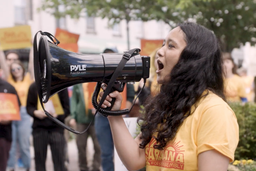
The standard story line for insurgent social movements of the left and right goes something like this: The country is sustained by good, hardworking, average people in the middle like us, but we have little or no power. For the left, these good people are the workers; for the right, they are the middle class of small business owners, farmers and white-collar workers. However, these good people are exploited and dominated by the few at the top; capitalists for the left, and the bureaucrats, internationalist financiers and atheists for the right.
The good, hardworking majority have a right to be angry, and they should organize to create social change that brings about a new social order. For the left, this is a transition to socialism, gender equality and racial equality; for the right, it’s a return to an idyllic world of small business, small government, male dominance and white Christian rule.
Social science research supports part of this picture through studies of social stratification and wealth distribution. There is indeed an obvious pecking order from top to bottom in terms of jobs, education and social status, although the reasons why some people end up on the bottom are far different from what the political right imagines. It is also well-documented that the few at the top have a highly disproportionate share of wealth and income. Indeed, wealth has not been this concentrated since 1929.
There’s good reason to believe that the top 1 percent of wealth holders—who, according to the most recent figures, own 47 percent of the nation’s financial wealth—have a dominant role in the economy and government. They can invest where and when they wish, and hire and fire most workers at will. They have a monopoly on policy expertise through thousands of charitable foundations and an array of think tanks. They have a huge number of lobbyists and public relations people. They can have a big impact on politicians through campaign donations. They get themselves appointed to top positions in Washington.
In trying to bring about egalitarian social change, however, it doesn’t make good political sense to frame this picture of economic concentration and class domination in terms of one social class against another. Defining the “opponents” as “the capitalists” or “the rich” is a strategic mistake. Because the problem is developing new policies and gaining political power, the struggle should be framed from the start as a political one, not an economic one. The “in-group” should be all those who come to embrace the program of the egalitarian movement, and the “out-group” should be all those who oppose such changes.
If the conflict is framed this way, an egalitarian coalition has a chance to win over the moderates, neutrals and independents who currently identify with capitalists and might be offended by blanket criticisms of them as a class. It may even attract dissident members of the capitalist class who transcend their class interests and in the process become very valuable in legitimating the movement to those in the middle who are hesitant to climb on board.
But the problem is not just labeling all capitalists as enemies. Once the conflict is framed in class terms, those defined as members of the working class take on all virtue, and those outside the working class are ignored or demonized, whether they are rich or not. Furthermore, doing politics in terms of class categories does not sit well with most of the everyday working people to whom it is meant to appeal. The whole thrust of the average Americans’ experience is to break down class distinctions, not heighten them. They do not like to think of themselves in terms of their class identity, which immediately reminds them that they are not rich and have a lower status than they might like.
————–
The ideal model for a more open-ended framing of a social conflict is provided by the civil rights movement, which defined the enemy not as “whites,” but as “racists” and “bigots.” Racists and bigots included most whites in the South at that time, of course, so there was a clear opposition. But at the same time, there was room for pro-integration whites. Drawing on the Christian tradition, the movement therefore was able to utilize the concepts of forgiveness, redemption and conversion in the service of strategic nonviolence to forge a black-white coalition. By opening its doors to people who believed in equal rights for African-Americans—whatever their class, race, religion or previous beliefs—the movement enabled people to change their attitudes without violating their self-images as decent people.
Similarly, if a “cross-class” coalition is needed to assemble a majority for an egalitarian program in the 21st century, then it is better to begin with a political framing of “us-versus-them” that does not define one class or another as the enemy. Studies by social psychologists show that an us-versus-them framing is a powerful basis for a social movement. An in-group definition provides a strong sense of solidarity. It makes possible social comparisons with privileged exclusionary groups, which can generate a sense of injustice and contribute to a willingness to act. The problem, then, is to define the out-group in such a way that people can abandon this group and join the in-group. Thus, the out-group should not be defined by characteristics that it cannot relinquish, such as gender, race, ethnicity, sexual orientation or class origins.
So how should the conflict over transforming American society be framed by nonviolent egalitarian activists? The designated opponents of the egalitarian activists should be the “corporate-conservative coalition” and the Republican Party. Framing the general conflict in terms of egalitarians versus corporate conservatives, and Democrats versus Republicans in the political arena, has two distinct advantages in addition to avoiding a demonization of “the rich” or the capitalist class. First, these are categories from which people can remove themselves. They can change their minds.
Second, these categories leave a great many as “third parties”—people who define themselves as independents and moderates—who do not feel labeled as enemies and put on the defensive by criticisms of the corporate-conservative coalition and the Republican Party. That leaves egalitarians with a potential majority of liberals, moderates, independents and Democrats to win to their side.
————–
But who is the egalitarian “we” that would battle the corporate-conservative coalition? It starts with those who currently make up the nonviolent insurgent groups in the United States: the coalition of white progressives, liberal people of color, progressive trade unionists, feminists, living-wage activists, environmentalists, gay and lesbian activists, global justice activists, and anti-sweatshop activists who work together on many issues and usually vote Democratic in partisan elections.
From there, the coalition has to build out to the neutrals, bystanders, moderates and skeptics who are the majority at the present time. The movement has to offer everyone a shared common political identity that does not attempt to downplay or erase their current social identities. And that is where the concept of “egalitarian” comes into the picture. Egalitarianism is not only a set of values that a great many Americans endorse in the abstract, but it can provide the basis for a collective social identity within the political arena for a coalition-based movement.
Once a framing in terms of egalitarian Democrats versus corporate conservatives and Republicans is in place, the chief executive officers of major corporations become fair game, because they call the shots for the corporate-conservative coalition and regularly oppose egalitarian policy proposals. So, too, should a wide range of business organizations be named and criticized, because they are on record with a set of policy recommendations that don’t benefit those in the egalitarian coalition. For that matter, specific Democrats can be criticized within this overall context, such as members of the Democratic Leadership Council, because they function as part of the corporate-conservative coalition.
But an attack on “the rich” or “the capitalist class,” or worse, “the capitalist pigs and bloodsuckers”? Then what about, for just one example, New Jersey Sen. Jon Corzine, the multimillionaire banker who has gone beyond his class interests to advocate a sharply defined progressive agenda? This Democrat opposed Bush’s tax cuts for the rich, wants an “activist” government, sees a universal health care system as a “basic right,” and opposes the death penalty.
Combined with programs for planning through the market, full employment, and an expansion of the earned income tax credit, the Corzine program would be a giant step forward in improving the day-to-day lives of the 80 percent of Americans who haven’t really benefited from the growth of the economy since the ’80s. Is there an egalitarian in America who would hesitate for one second in accepting this package as a great start? Shouldn’t Corzine, a rich, straight, white male multimillionaire, with a wife who is a strong feminist, be in the coalition? Is he one of “us” or one of “them”?
The good, hardworking majority have a right to be angry, and they should organize to create social change that brings about a new social order. For the left, this is a transition to socialism, gender equality and racial equality; for the right, it’s a return to an idyllic world of small business, small government, male dominance and white Christian rule.
Social science research supports part of this picture through studies of social stratification and wealth distribution. There is indeed an obvious pecking order from top to bottom in terms of jobs, education and social status, although the reasons why some people end up on the bottom are far different from what the political right imagines. It is also well-documented that the few at the top have a highly disproportionate share of wealth and income. Indeed, wealth has not been this concentrated since 1929.
There’s good reason to believe that the top 1 percent of wealth holders—who, according to the most recent figures, own 47 percent of the nation’s financial wealth—have a dominant role in the economy and government. They can invest where and when they wish, and hire and fire most workers at will. They have a monopoly on policy expertise through thousands of charitable foundations and an array of think tanks. They have a huge number of lobbyists and public relations people. They can have a big impact on politicians through campaign donations. They get themselves appointed to top positions in Washington.
In trying to bring about egalitarian social change, however, it doesn’t make good political sense to frame this picture of economic concentration and class domination in terms of one social class against another. Defining the “opponents” as “the capitalists” or “the rich” is a strategic mistake. Because the problem is developing new policies and gaining political power, the struggle should be framed from the start as a political one, not an economic one. The “in-group” should be all those who come to embrace the program of the egalitarian movement, and the “out-group” should be all those who oppose such changes.
If the conflict is framed this way, an egalitarian coalition has a chance to win over the moderates, neutrals and independents who currently identify with capitalists and might be offended by blanket criticisms of them as a class. It may even attract dissident members of the capitalist class who transcend their class interests and in the process become very valuable in legitimating the movement to those in the middle who are hesitant to climb on board.
But the problem is not just labeling all capitalists as enemies. Once the conflict is framed in class terms, those defined as members of the working class take on all virtue, and those outside the working class are ignored or demonized, whether they are rich or not. Furthermore, doing politics in terms of class categories does not sit well with most of the everyday working people to whom it is meant to appeal. The whole thrust of the average Americans’ experience is to break down class distinctions, not heighten them. They do not like to think of themselves in terms of their class identity, which immediately reminds them that they are not rich and have a lower status than they might like.
————–
The ideal model for a more open-ended framing of a social conflict is provided by the civil rights movement, which defined the enemy not as “whites,” but as “racists” and “bigots.” Racists and bigots included most whites in the South at that time, of course, so there was a clear opposition. But at the same time, there was room for pro-integration whites. Drawing on the Christian tradition, the movement therefore was able to utilize the concepts of forgiveness, redemption and conversion in the service of strategic nonviolence to forge a black-white coalition. By opening its doors to people who believed in equal rights for African-Americans—whatever their class, race, religion or previous beliefs—the movement enabled people to change their attitudes without violating their self-images as decent people.
Similarly, if a “cross-class” coalition is needed to assemble a majority for an egalitarian program in the 21st century, then it is better to begin with a political framing of “us-versus-them” that does not define one class or another as the enemy. Studies by social psychologists show that an us-versus-them framing is a powerful basis for a social movement. An in-group definition provides a strong sense of solidarity. It makes possible social comparisons with privileged exclusionary groups, which can generate a sense of injustice and contribute to a willingness to act. The problem, then, is to define the out-group in such a way that people can abandon this group and join the in-group. Thus, the out-group should not be defined by characteristics that it cannot relinquish, such as gender, race, ethnicity, sexual orientation or class origins.
So how should the conflict over transforming American society be framed by nonviolent egalitarian activists? The designated opponents of the egalitarian activists should be the “corporate-conservative coalition” and the Republican Party. Framing the general conflict in terms of egalitarians versus corporate conservatives, and Democrats versus Republicans in the political arena, has two distinct advantages in addition to avoiding a demonization of “the rich” or the capitalist class. First, these are categories from which people can remove themselves. They can change their minds.
Second, these categories leave a great many as “third parties”—people who define themselves as independents and moderates—who do not feel labeled as enemies and put on the defensive by criticisms of the corporate-conservative coalition and the Republican Party. That leaves egalitarians with a potential majority of liberals, moderates, independents and Democrats to win to their side.
————–
But who is the egalitarian “we” that would battle the corporate-conservative coalition? It starts with those who currently make up the nonviolent insurgent groups in the United States: the coalition of white progressives, liberal people of color, progressive trade unionists, feminists, living-wage activists, environmentalists, gay and lesbian activists, global justice activists, and anti-sweatshop activists who work together on many issues and usually vote Democratic in partisan elections.
From there, the coalition has to build out to the neutrals, bystanders, moderates and skeptics who are the majority at the present time. The movement has to offer everyone a shared common political identity that does not attempt to downplay or erase their current social identities. And that is where the concept of “egalitarian” comes into the picture. Egalitarianism is not only a set of values that a great many Americans endorse in the abstract, but it can provide the basis for a collective social identity within the political arena for a coalition-based movement.
Once a framing in terms of egalitarian Democrats versus corporate conservatives and Republicans is in place, the chief executive officers of major corporations become fair game, because they call the shots for the corporate-conservative coalition and regularly oppose egalitarian policy proposals. So, too, should a wide range of business organizations be named and criticized, because they are on record with a set of policy recommendations that don’t benefit those in the egalitarian coalition. For that matter, specific Democrats can be criticized within this overall context, such as members of the Democratic Leadership Council, because they function as part of the corporate-conservative coalition.
But an attack on “the rich” or “the capitalist class,” or worse, “the capitalist pigs and bloodsuckers”? Then what about, for just one example, New Jersey Sen. Jon Corzine, the multimillionaire banker who has gone beyond his class interests to advocate a sharply defined progressive agenda? This Democrat opposed Bush’s tax cuts for the rich, wants an “activist” government, sees a universal health care system as a “basic right,” and opposes the death penalty.
Combined with programs for planning through the market, full employment, and an expansion of the earned income tax credit, the Corzine program would be a giant step forward in improving the day-to-day lives of the 80 percent of Americans who haven’t really benefited from the growth of the economy since the ’80s. Is there an egalitarian in America who would hesitate for one second in accepting this package as a great start? Shouldn’t Corzine, a rich, straight, white male multimillionaire, with a wife who is a strong feminist, be in the coalition? Is he one of “us” or one of “them”?
Please consider supporting our work.

I hope you found this article important. Before you leave, I want to ask you to consider supporting our work with a donation. In These Times needs readers like you to help sustain our mission. We don’t depend on—or want—corporate advertising or deep-pocketed billionaires to fund our journalism. We’re supported by you, the reader, so we can focus on covering the issues that matter most to the progressive movement without fear or compromise.
Our work isn’t hidden behind a paywall because of people like you who support our journalism. We want to keep it that way. If you value the work we do and the movements we cover, please consider donating to In These Times.
G. William Domhoff is the author of Who Rules America? and The Power Elite and the State. He lives in Santa Cruz, where he is a sociology professor at the University of California.





